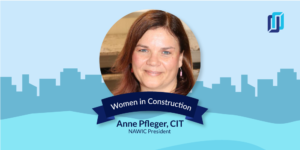
Anne Pfleger, CIT, is the current President of the National Association of Women in Construction (NAWIC), an organization whose mission is to advance the development of women working in the construction industry. She is also currently the estimating, safety, and human resources administrator at Charles Construction Services in Findlay, Ohio.
Women in Construction Week is a time to recognize the achievements of all the women who remain a vital faction in what is still considered to be a male-dominated industry. Anne discusses NAWIC’s priorities and programs, the changing role of women in the industry, and the importance of mentorship and community to help women in construction on their own paths to career success.
Empowering women in the construction industry
Dawn: First things first: Who is NAWIC, and what are your goals?
Anne: The National Association of Women in Construction, also known as NAWIC, has 117 chapters across the United States. We also have chapters in D.C. and Guam included in that 117. It was founded as Women in Construction of Fort Worth, Texas, in 1953, to enhance the success of women in the construction industry. In 1955, the charter was expanded to allow chapters to form across the country, and that’s how the National Association of Women in Construction was born.
Construction is the only industry that encompasses almost every professional discipline. Literally, every career sector is available to both women and men. Trades, project management, administration, law, finance, insurance — the list is virtually endless.
Related: 1,001 Women in Construction Share Highlights & Challenges
NAWIC brings women from each of these career sectors together. The essential purpose of NAWIC is to build leaders to impact the direction of the construction industry. And with our 66 years of experience, we continue to provide support to thousands of members and help them flourish both professionally and personally. We do that locally, regionally, and nationally by providing opportunities through monthly chapter meetings and regional and national conferences. We have industry councils, task forces, committees, interactive webinars, certifications, professional development programs, and leadership roles within NAWIC.
“We’re often seeing women…both in the field with boots on the ground and sitting at the table, impacting the direction of the construction industry.“
How do you think women’s role in the industry has changed since NAWIC’s founding in 1953?
I was asked a similar question in a recent interview with one of NAWIC’s association partners: Has the prevalence of women in the construction industry changed since you joined NAWIC in 2006? And I think this response is fitting even going back to the ’50s, because I said, “Yes, the industry has changed in the sense that construction is no longer a male-dominated industry, but a male-populated industry.”
We’re often seeing women more in the forefront of construction, both in the field with boots on the ground and sitting at the table, impacting the direction of the construction industry.
How has NAWIC helped you in your career journey?
Never in a million years did I think I could be president of a national association. NAWIC has provided me countless opportunities to develop my leadership skills, which in turn gives me more confidence in my career. I started as a project administrator, but with the help and support of NAWIC members, I finished my college degree 20 years after I started and moved from project administration to estimating pre-engineered metal buildings. I also help in the safety, HR, and IT departments because of the diversity of knowledge I’ve gained from NAWIC.
“It’s wonderful when you’re passing a building or driving on a road, and you can tell your fellow passengers, ‘I had a part in building that.’ Just having that feeling of success in your career is amazing.“
Finding your support system: The importance of mentorship at any career stage
Why should women consider a career in the construction industry?
Besides being the top industry that narrows the pay gap — the construction industry offers women 96 cents for every dollar a man makes, according to a 2020 study by PayScale — construction also provides a sense of accomplishment when projects are completed. It’s wonderful when you’re passing a building or driving on a road, and you can tell your fellow passengers, “I had a part in building that.” Just having that feeling of success in your career is amazing.
Do you have any advice for women who are beginning their career in construction?
First thing you want to do is find mentors, and they can be men or women. We are finding that men are very supportive of women in the industry, and they want to help us to succeed, to be an integral part of the industry.
You want to have a variety of different mentors and make sure that you have mentors throughout your career because it can rejuvenate your career at any stage, it improves your personal productivity, it strengthens leadership skills, and it also increases that career satisfaction that I mentioned earlier. It encourages sharing of information. You develop a loyal support group, and it encourages women to achieve their full potential. And as I mentioned, having a mentor at any time can be beneficial, not just at the onset of one’s career.
Mentorship is really a key part of the success of women in the industry. Because we’re still only about 10% of the whole construction industry, which back in the ’50s, I think we were not even a full percent. We have made progress, it’s just that we haven’t made substantial progress. We’re finally over 10% — and that’s taken more than 10 years, to go from 9% to 10%.
Of course, depending on your career path, you will need training, whether it be a tradeswoman going through an apprenticeship program, or a project manager or superintendent, you might need a college degree. But you don’t always have to have a college degree to have a great career in construction.
I mentioned earlier that it took me 20 years to finish my degree. And where I was in my life and career, it wasn’t so much that I had to have that degree to succeed in my career, but a sense of accomplishment obtaining it.

Thea Dudley teaches credit & collections
Join the free certificate course to learn the foundations of credit & collections in construction with 30-year industry veteran Thea Dudley.
The next generation of women in construction
What are some of the programs that NAWIC provides for its members?
In addition to what I stated above supporting women in the industry, NAWIC has a separate foundation, the NAWIC Education Foundation (NEF) to educate the younger generation with programs starting as early as kindergarten, going up through high school into college. NEF also offers adult certifications while working in the construction industry.
Block Kids is a program for grade school students which is a competition with Legos. They have to build something that is construction-related with Legos, a piece of aluminum foil, cardboard, some string, and/or a rock. It can’t have any people or animals in it.
Moving up to junior high, there is a build-a-shed type of program that’s offered. NEF also has for high school and college levels, a design drafting competition where they get a project like building a tiny house. They have to design the plans based on the parameters given.
“Mentorship is really a key part of the success of women in the industry.”
All of these competitions start with our chapters, at the local level. And then the winners move up to the region, and then the region winners move up to the national level.
Some of our chapters do a Camp NAWIC, which is typically a week-long camp that involves girls actually getting hands-on experience doing different things, they can learn how to read blueprints and do some electrical, plumbing, block masonry, and other types of activities. We really want to try to educate them to let them know that they can do anything that they want to do if they really enjoy the work and can put their minds to it.
Something else that NAWIC is doing, we’re getting more in the forefront, and people are hearing more about us. We’re developing quite a few strategic partnerships. And one of the partnerships that we started this year is with an organization called Nepris.
They connect classrooms to different types of careers. We just launched this program a couple of weeks ago, and I have to tell you that Nepris was overwhelmed by the number of NAWIC members that wanted to participate. You fill out some information on the site, and they’ll pair you up with a classroom where you can speak to students about your career, what you do and how you got there.
The great thing about it is, with how we are embracing technology right now, I was paired up with a school in Missouri during my lunch hour in Ohio.
We’ve got some other partnerships similar to NEF and Nepris that we’re working on as well. Because until young girls see that women can have a viable career in construction, they can’t see themselves doing it.
Women in construction create a vital community
Talk about Women in Construction Week — since that’s coming up next week —and what NAWIC’s role is in that.
NAWIC started Women in Construction Week back in 1998. It was originally held in September because that’s our founding month, but after a couple of years we decided that it would be paired better with Women in History Month, so we moved it to March.
It’s always the first full week, so in 2021 it’s March 7–13. We have chapters all across the country promoting women in construction during the week. They are billboards; they’re doing lunch-and-learns. We actually have a panel with one of our international affiliates, NAWIC United Kingdom which we are very excited about. The goal is to get the word out there about women in construction.
“Until young girls see that women can have a viable career in construction, they can’t see themselves doing it.“
Of course, this year is a little bit more challenging with some of our chapters still not being able to meet in person, we’re doing a lot of things virtually.
One of the regions embracing this is doing what they call “passing the hammer” by having each chapter create a video telling a little bit about their chapter, and then they literally pass the hammer onto the next chapter, and the next chapter picks it up. That video is available online at NAWIC SE WIC Week, and is a great way to let people know about women in construction.
Is there anything else that you’d like to let people know about NAWIC?
I’d like to let everybody know that NAWIC is a huge support system, and we really do build leaders from any aspect. As I mentioned earlier, I never thought I would be a national president. I started out as an administrator; people might say a secretary position. But I grew and developed my skills in a safe environment which is another great thing about NAWIC.
We’re all together in this. We’re all women in the construction industry; we can safely gain our confidence and work towards our goal to be and do whatever we want.
How would someone find out more about NAWIC?
Go to the NAWIC website, www.nawic.org, to learn more about NAWIC and how to sign up. For the month of March 2021, we’re running a promotion where you can join NAWIC for six months for $129 and get all of the benefits of being a NAWIC member, except for the voting part. This gives brand new members a chance to learn about our association. Again, through the entire month of March 2021, if you sign up here as a brand-new member, it’s $129 for six months.